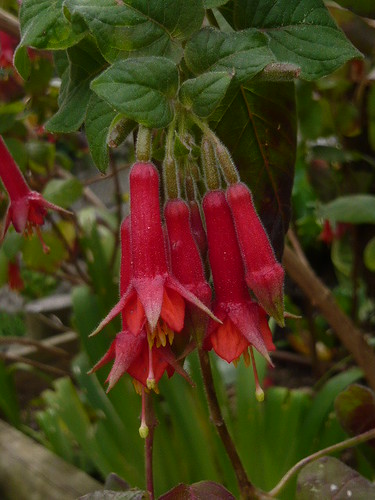Overwintering Fuchsias
Overwintering as the name suggests is the treatment of a fuchsia to protect it during winter so that it will survive to perform again next year. All Fuchsias can be overwintered as cuttings and I recommend that as a belt and braces approach.
Overwintering Hardy Fuchias.
- Hardy cultivars are bred and grown to survive British winters and do well particularly in the south. Fuchsia magellanica ‘Gracilis’, Happy, Lady Thumb, C J Howlett, Graf Witte, Lena, Margaret and Thompsonii are hardy varieties with an AGM.
- The micro climate for a Fuchsia can help it survive. If grown in full sun the wood will ripen to a firm brown twig that resists freezing. Well drained soil prevents water logging.
- Plant deeply, at least 4″, so that buds below the soil are protected.
- I cut back the soft growth in October and cover the root and shoot area with bracken or peat substitute.
- In spring I prune down to just one or two buds at the base to encourage new growth.
Overwintering Decorative Fuchsias
- Unless your fuchsia is known to be hardy it is safer to assume it is not and treat it accordingly.
- Take semi-ripe hardwood cuttings before frost in October and keep in a frost free room to root over winter.
- The whole plant can be overwintered for several years by making it dormant from October. Stop watering, harden the wood outdoors in the sunshine where possible.
- Put the plant in a cool, dry frost free place. If it starts shooting it is too warm.
- Water thoroughly with tepid water only when the root ball becomes totally dry.
Restarting Overwintered Fuchsias
- Hardy Outdoor varieties will start themselves. Pull off the bracken leaves after the danger of frost has passed.
- In spring bring out the pot plants and prune back to one or two buds per shoot. Cut out crossing branches and make the plant open.
- Repot in fresh compost.
- Place in the light and warmth and syringe the branches. Do not over-water, wait until shoots are growing strongly before any feeding.
- Stop the plants to get bigger flower heads. Beware overwintered plants can start to loose the size of flower after several seasons.
See also Fuchsia Pink Fantasia on Gardeners tips

2 thoughts on “Overwintering Fuchsias”
Comments are closed.